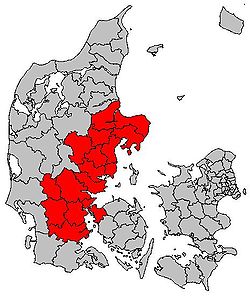| Demographics of Denmark | |
|---|---|
 Population pyramid of Denmark in 2020 | |
| Population | 6,027,601 (2025 1 December est.) |
| Growth rate | 1.0085% (2022 est.) |
| Birth rate | 9.85 births/1,000 population |
| Death rate | 10.02 deaths/1,000 population |
| Life expectancy | 81.66 years |
| • male | 79.74 years |
| • female | 83.71 years |
| Fertility rate | 1.495 children born/woman (2023) [1] |
| Infant mortality rate | 3.04 deaths/1,000 live births |
| Net migration rate | 2.73 migrant(s)/1,000 population (2022 est.) |
| Age structure | |
| 0–14 years | 16.42% |
| 65 and over | 19.91% |
| Sex ratio | |
| Total | 0.99 male(s)/female (2022 est.) |
| At birth | 1.07 male(s)/female |
| 65 and over | 0.7 male(s)/female |
| Nationality | |
| Nationality | Danish |
| Major ethnic | Danes |
| Minor ethnic | |
| Language | |
| Official | Danish, Faroese and Greenlandic |
| Spoken | Languages of Denmark |
Demographic features of the population of Denmark proper, part of the Danish Realm, include ethnicity, education level, health of the populace, economic status, religious affiliations, and other aspects.
Contents
- Population
- Fertility
- Historical fertility rates
- Average age of the mother at her first birth
- Life expectancy
- Age structure
- Ethnic and origin groups
- Historic minorities
- Modern minorities
- Vital statistics
- Current vital statistics
- Total fertility rates
- Structure of the population
- Immigration
- Denmark net migration
- Urban areas
- Religion
- Employment and income
- Taxation and benefits
- Homelessness
- See also
- Notes
- References
- External links




















